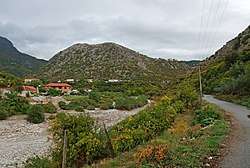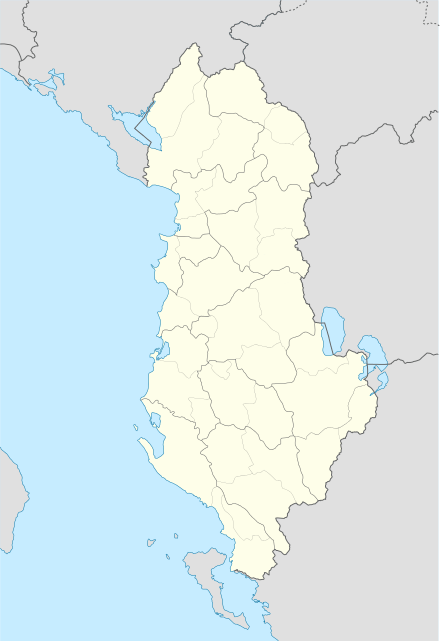Drisht
Drisht (definite Albanian form: Drishti) is a village, former bishopric and Latin titular see with an Ancient and notable medieval history (Latin Drivastum, Italian Drivasto) in Albania, 6 km from Mes Bridge (Albanian: Ura e Mesit). It is located in the former municipality Postribë in the Shkodër County.[1] At the 2015 local government reform it became part of the municipality Shkodër.[2] The ruined 13th Century Drisht Castle is on a hilltop 800m above sea level. The ruins of the castle itself contains the remains of 11 houses, and below the ruins of the castle, and above the modern village of Drisht are further archeological remains of late-Roman and medieval Drivastum.
Drisht | |
|---|---|
 | |
 Drisht | |
| Coordinates: 42°7′23″N 19°35′29″E | |
| Country | |
| County | Shkodër |
| Municipality | Shkodër |
| Municipal unit | Postribë |
| Time zone | UTC+1 (CET) |
| • Summer (DST) | UTC+2 (CEST) |
History
The settlement of Drivastum is known to have existed before the tenth century AD. The Diocese of Drivastum became a suffragan of the Archdiocese of Antivari in 1089, after it was transferred from the Archdiocese of Ragusa.[3]
In 1081—1116 Drivastum belonged to the kingdom of Duklja.[4] In 1183, Serbian Stefan Nemanja conquered Drivast and its surroundings.
In 1241, the city was plundered by Tatars as they were advancing east across Zeta while heading home. Scholars estimate that Drivast was taken by the Balšići ca. spring of 1362. However, it is known that by 1363, they had captured Drivast and nearby Scutari.
In 1393, Đurađ II Balšić, having negotiated his freedom from Ottoman captivity, submitted to the Great Sultan's suzerainty and surrendered Drivast, Sveti Srđ and Scutari. However, Đurađ soon ended his vassalage to the Ottomans and reconquered the cities he had surrendered mere months before. In 1395, knowing he could not outlast an Ottoman attack, he handed these cities, including Drivast, to dogal Venice in exchange for 1,000 ducats yearly.
In 1399, the townspeople in Drivasto (the city's new Italian name) and Scutari started a revolt against Venice, angered at the high taxes they were paying. The revolt lasted for three years, when Venetian troops managed to control the situation. However, the areas surrounding Drivast and Scutari no longer recognized Venetian authority.
Angered by Venice's policy on his former lands and its trade monopoly policy that caused an economic stagnation in his ports, Đurađ II sent troops to his former lands, including Drivast, breaking his peace treaty with Venice. Đurađ's actions led to Venice believing that he had a major role in the uprising's initiation. Scholars are unsure whether this accusation is accurate. The Turks also decided to send raiding parties to these rebellious lands.
In 1423 Đurađ Branković conquered Drivast and annexed it to Serbian Despotate. Supported by Ottomans, Gojčin Crnojević and Little Tanuš Dukađin, Maramonte plundered region around Scutari and Ulcinj and attacked Drivast in 1429, but failed to capture it.[5]
In August 1442, Venice took Drivast from Serbian Despot Đurađ Branković. Native citizens of Drivast were hostile toward advances of Albanians and Serbs so they accepted Venetian suzerainty only under condition that Venice wouldn't employ Albanian pronoiers and to return to the city land Serbian despot gave to Serbs.[6]
In 1447, Skanderbeg demanded from the Venetians to give control over Drivast to him, along with the lands which earlier belonged to Lekë Zakarija. However, the Venetians refused to accept his demands and Skanderbeg started the war against Venice.
In March 1451 Lekë Dukagjini and Božidar Dushmani planned to attack Venetian controlled Drivast.[7] Their plot was discovered and Božidar was forced to exile.[8]
In September 1478, Drivast was captured by the Ottomans.
Ecclesiastical History
The bishopric was founded around 400 AD, as a suffragan of its Late Roman province Dalmatia Superior's capital Doclea's Metropolitan bishop.
Drivastum became a suffragan of the Archdiocese of Antivari in 1089, after it was transferred from the Archdiocese of Ragusa.[9] The townspeople of Drivast murdered one of their bishops in the thirteenth century.
- Suffragan Bishops of Drivasto
(all Roman Rite; incomplete : first centuries unavailable)
- Domenico (? – death 1322)
- Nicola, Augustinian Order (O.E.S.A.) (1323.02.28 – 1324.12.17), later Bishop of Argos (1324.12.17 – ?)
- Bernardo (1351.12.26 – ?)
- Giovanni Andrea (1359 – 1373.05.18), later Metropolitan Archbishop of Bar (Montenegro) (1373.05.18 – 1382)
- Bernardo (1373 – 1374.04.29), later Bishop of Kotor (Montenegro) (1374.04.29 – ?)
- Atanasio (1374.04.29 – ?)
- Nicola Bazie, Friars Minor (O.F.M.) (1391.02.15 – 1394.02.16), later Bishop of Caorle (1394.02.16 – ?)
- Andrea de Montanea, O.F.M. (1398.08.16 – ?)
- Bartolomeo Puonbiolus (1400? – 1404 deposed)
- Francesco da Scutari, O.F.M. (1405.12.01 – 1424.05.24), later Bishop of Ulcinj (1424.05.24 – ?)
- Nicola Wallibassa (1424.05.24 – 1425 not possessed), previously Bishop of Ulcinj (1414.03.14 – 1424.05.24)
- Dionigi da Knin, Dominican Order (O.P.) (1425.11.29 – 1428.10.11 deposed)
- Michele Paoli (1428.10.11 – death 1445?), previously Bishop of Balecio (1424.09.01 – 1428.10.11)
- Paolo Dusso (1445.12.22 – 1455), previously Bishop of Suacia (1440.11.16 – 1445.12.22)
- Terslav (? – death 1489)
- Francesco de Ecclesia (1489.12.02 – ?)
- Benedetto Kornis, Norbertines (O. Praem.) (1512.10.29 – ?)
- Francesco de Mora, O.F.M. (1518.11.10 – death 1520)
- Giovanni de Zaguis, Benedictine Order (O.S.B.) (1520.01.13 – death 1520?)
- Gonzalo de Ubeda, Mercedarians (O. de M.) (1521.02.06 – death 1525?)
- Bishop-elect Pedro Fernández de Jaén, O.P. (1525.03.20 – ?), Auxiliary Bishop of Jaén (Spain) (1525.03.20 – ?)
- Francesco de Solis (? – death 1540?)[10]
- Alfonso de Sanabria (1541.05.04 – ?)
- Gerolamo Lucich, O.F.M. (1636.03.03 – death 1648.01.02)
The residential see was suppressed in 1650, its territory being merged into the Diocese of Shkodrë (in Albania).
Titular see
In 1933 the diocese was nominally restored as Latin Titular bishopric of Drivastum (Drivasto in Curiate Italian).
It has had the following incumbents, of the fitting episcopal (lowest) rank with two archiepiscopal (intermediary) exceptions :
- Cipriano Cassini (趙信義), Jesuits (S.J.) (1936.12.23 – 1946.04.11)
- Daniel Liston, Holy Ghost Fathers (C.S.Sp.) (1947.03.13 – 1949.12.19)
- João Floriano Loewenau, Friars Minor (O.F.M.) (1950.09.08 – 1979.06.04)
- Rafael Barraza Sánchez (1979.10.26 – 1981.10.19)
- Titular Archbishop Traian Crisan (1981.12.07 – 1990.11.06)
- Bruno Bertagna (1990.12.15 – 2007.02.15) (later Archbishop)
- Titular Archbishop Bruno Bertagna (2007.02.15 – 2013.10.31)
- Paul Tighe (2015.12.19 – ...), Adjunct Secretary of Pontifical Council for Culture, Member of Vatican Media Committee
Modern Drisht
The population of modern Drisht is predominantly Muslim and Albanian speaking.[11] Drisht is accessible by a 4x4 or by walking.[12]
References
- "Location of Drisht". Retrieved 6/3/2010. Check date values in:
|accessdate=(help) - "Law nr. 115/2014" (PDF). Archived from the original (PDF) on 2015-09-24. Retrieved 2015-07-06.
- Historical dictionary of Albania - Page 118 Robert Elsie - 2010 "DRISHT. Archeological site, medieval fortress, and village in the mountains above the Kir valley east of Shkodra. In the ninth century, Drisht (medieval Drivastum,..."
- Bogdanović, Dimitrije (1990). Knjiga o Kosovu: razgovori o Kosovu (in Serbian). Književne novine. p. 36. Retrieved 21 January 2012.
У доба највеће проширености дукљанске српске државе под Бодином (1081-1116) њеним границама је била обухваћена читава данашња северна Албанија, ...северно од Дрима, али и пространа облас јужно од Дрима укључујући све мале градове у скадарским жупама (Балеч, Дриваст, Сард, Дањ, Сапа, Шаст, Св. Срђ и Влах)
- Ćorović, Vladimir (13 January 2014). Istorija srpskog naroda. eBook Portal. p. 340. GGKEY:XPENWQLDTZF.
Са турском помоћу кренуо је Марамонте крајем 1429. год. на Зету и похарао околину Скадра и Улциња. Напао је и Дриваст, и заузео му је подграђе, али самог града није освојио. У тим борбама учествовали су на његовој страни Гојчин Црнојевић и Мали Тануш из племена Дукађуна. Млеци су уценили Марамонтову главу са 500 дуката. Деспот га је међутим онемогућио код самих Турака.
- Božić 1979, p. 290
Старо градско становништво романског порекла, јако непријатељски расположено према продирању Словена и Албанаца, придружило ce Млечанима 1442. под условом да не дозволе Албанцима да ту стичу проније и да ce земље устушвене Србима за време деспотове власти врате „општини". Република није могла да изврши сва обећања пошто су политичке мене доводиле до успона нових верних поданика
- Schmitt, Oliver Jens (2001), Das venezianische Albanien (1392-1479), München: R. Oldenbourg Verlag GmbH München, p. 308, ISBN 3-486-56569--9, retrieved 17 January 2012,
Die eigene Herrschaft im Norden war nicht ungefährdet, wie die Aufdeckung eines Anschlags Božidar Dushmans und Leka Dukagjins gegen Drivasto erwies (Marz 1451),..
- Bešić, Zarij M. (1970). Istorija Črne Gore, Volume 2, Part 2 (in Serbian). Titograd: Redakcija za istoriju Črne Gore. Retrieved 17 January 2012.
У Дривасту je окупљао млетачке противнике Божидар Душман и, у спрези с Леком Дукађином, припремао побуну у граду и по селима. Завјера je откривена и Bијеће четрдесеторице осудило га je у марту 1451. год. на тридесетогодишње изгнанство с Млетачких поседа у Албанији
- Historical dictionary of Albania - Page 118 Robert Elsie - 2010 "DRISHT. Archeological site, medieval fortress, and village in the mountains above the Kir valley east of Shkodra. ..."
- catholic-hierarchy.org: "Bishop Francisco Solís" retrieved February 7, 2015
- Great Britain. Naval Intelligence Division, Sir John Linton Myres, Harold St. John Loyd Winterbotham - 1945 The tribesmen speak Albanian, but there have been Serbian immigrants. The whole district is backward, and suffered ... (12) DRISHTI (Drisht) is a bajrak of the Postriba (53) group or district. It is almost entirely Moslem and occupies ..."
- Albania: The Bradt Travel Guide - Page 160 Gillian Gloyer - 2008 "Drishti is reached along a track on the other side of the bridge from the good road; it is driveable, in a 4x4 vehicle, but it might be as quick to walk. LEZHA Telephone code: 0215 Albanians are always very keen for foreigners to visit .."
Sources and external links
| Wikimedia Commons has media related to Drisht. |
- Božić, Ivan (1979). Nemirno pomorje XV veka (in Serbian). Belgrade: Srpska književna zadruga. OCLC 5845972. Retrieved 12 February 2012.CS1 maint: ref=harv (link)
- GCatholic with incumbent bio links
- External links
- Photo of the ruined castle "Drisht, Drishti" (in Albanian). Missing or empty
|url=(help)
Further reading
- Ippen, Theodor (1900), "Stari spomenici u Albaniji", Glasnik Zemaljskog muzeja u Bosni i Hercegovini, Zbirka povjesti, 12, Sarajevo, Austria-Hungary: Zemaljska štamparija, pp. 511–531
